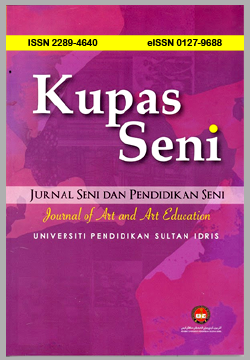The Applicability of Awan Larat Motif on Contemporary Building Design
DOI:
https://doi.org/10.37134/kupasseni.vol9.1.8.2021Keywords:
Awan larat, traditional Malay houses, contemporary buildings, Malay woodcarvings, sustainabilityAbstract
After the coming of Islam in the 14th century, the artistic craft development of the Malay society has shifted more on the concept of Tawhid which is to achieve the understanding of the oneness of God. As a result, one of the Malay traditional ornaments which are called ‘awan larat’ serves as a symbol that was decorated in most traditional Malay houses to portray the significance relationship between man, the universe and its Creator. However, due to the modernization these days, this traditional form of the motif is slowly being neglected and refuse to apply to contemporary buildings due to technological advancement as well as lack of interest and appreciation among Malay society. Therefore, this study aims to understand in depth the significance of applying this motif to the contemporary building as a matter to increase the level of awareness among Malay society regarding the values of the Malay Cultural Heritage. Experts and scholars from the background of Malay cultural studies were chosen to gain various significance perspectives of ‘awan larat’ and its appropriateness to be applied on contemporary buildings. Results and findings from this study found that time, cost and personal preferences of patrons were the factors that influenced the lack of appreciation in implementing ‘awan larat’ as a decoration on contemporary buildings. It can be established that awan larat has a unique character, which allows versatility for it to be used in various forms and purposes which have its own values and uniqueness to be uplifted. Hence, it is important to ensure that this area of study needs to be revised and uplifted in order to sustain its spirits in subsequent years.
Downloads
References
Abdul Halim Nasir. (1986). Ukiran kayu Melayu tradisi. Kuala Lumpur: Dewan Bahasa dan Pustaka.
Andaya, B.W., & Andaya, L.Y. (1982). A History of Malaysia, London: macmillan Press Ltd.
Barthes, R. (1977). Rhetoric of the image. In Heath, S. (Ed.) Image, music, text, pp. 32–51. London: Fontana
Chandler, D. (2014). Semiotics the basics. New York: Routledge
Che Husna Azhari. (2016, April 25). Personal communication.
Gun Faisal., & Yohannes Firzal. (2020). Chinese-Malay wood carving: the Kapitan house at Bagansiapiapi. IOP Conference Series: Earth and Environmental Science. 452. 012059. 10.1088/1755-1315/452/1/012059.
Hajimia, H. (2014). Research method – sampling. Retrieved from https://www.slideshare.net/hafizahhajimia/research-method-sampling
Hamdzun Haron., Nor Afian Yusof., Mohamad Taha., & Narimah Abdul Mutalib. (2014). Motifs of Nature in Malay Traditional Craft. Middle-East Journal of Scientific Research, 21(1), 169-180.
Harwell, R. M. (2011). Research design: Qualitative, quantitative, and mixed methods: Pursuing ideas as the keystone of exemplary inquir. Educational Psychology.
Haziyah Hussin, Zawiyah Baba., & Aminuddin Hassan. (2012). The philosophy in the creation of traditional Malay carving motifs in Peninsula Malaysia. Geografia: Malaysian Journal of Society and Space, 8(7), 88-95.
Hox, Joop., & Boeije, Hennie. (2010). Data collection, primary versus secondary.. Encyclopedia of Social Measurement. 1. 10.1016/B0-12-369398-5/00041-4.
Ian Dey. (1993). Qualitative Data Analysis: A User-Friendly Guide. Routledge, USA.
Ismail Said., & Ahmad Saifudin Abdullah. (2001). Spesis-spesis kayu dalam seni ukiran Melayu. Johor Bahru: Penerbit UTM.
Ismail Said., & Zumairah Kamarudin. (2010). Carving motifs in timber house of Kelantan and Terengganu: Sustaining Malay architectural identity [PDF Document]. retrieved from http://fab.utm.my/ismail/files/2014/12/carving-motifs-in-timber-houses-of-kelantan-and-terengganu.pdf
Juliana J., & Hetty Zaharani. (2019). The Philosophical Revitalization of Malay Motif Ornament in the Design of Woven Gedebong (Catri N Art, Rimbang Sekampung Village). 10.18502/kss.v3i19.4868.
Lamya, L. F. (1985). Islam and art. National Hijra Council. Islamabad: Pakistan.
Lili Peng., & Shiqing Huang. (2021). Application of Building Informationization in Green Building Design. 10.1007/978-3-030-74814-2_48.
Maisarah Ali., Puteri Shireen Jahn Kassim., Abu Dzar Samsudin., & Tengku Anis Qarihah Raja Abdul Kadir. (2020). The Three Layerings of Malay Aristocratic Ornamentations: Survival of Semantic Categories Amidst Stylistic Changes.
Mohammed Badaruddin., Simon Soon., Luqman Lee., Zaimie Sahibil., & Muhammad Luqman Mohd Saad. (2019). Theories and Methods in Analysing Traditional Malay Motif Designs: An Overview Comparison. International Journal of Heritage, Art and Multimedia. 56-71. 10.35631/ijham.25005.
Mohd Taib Osman. (1997). Islamic civilization in the Malay world. Kuala Lumpur: Dewan Bahasa dan Pustaka.
Othman Nor., Nordin Misnat., Haryati Isa., & Norashikin Karim. (2021). Space Organization in Perak Malay Traditional House. Malaysian Journal of Sustainable Environment. 8. 103. 10.24191/myse.v8i1.12663.
Sabrizaa Rashid., Mohd Nurfaisal Baharuddin., & Kartina Alauddin. (2021). The History and Transformation Of Perak Malay Traditional House. Malaysian Journal of Sustainable Environment. 8. 71. 10.24191/myse.v8i1.12661.
Shah, R., Pandit, R., & Gaur, M. (2021). Role of Building Design in Sustainable Green Development: A Review. 10.1007/978-3-030-61891-9_4.
Sojak, S. D. B. M., & Utaberta, N. (2013). Typological Study of Traditional Mosque Ornamentation in Malaysia-Comparison Between Traditional and Modern Mosque. World Academy of Science, Engineering and Technology, 67, 624-631.
Sumardianshah Silah., Ruzaika Omar Basaree., Badrul Isaa., & Raiha Shahanaz Redzuan. (2013). Tradition and transformation: the structure of Malay woodcarving motifs in craft education. Procedia-Social and Behavioral Sciences, 90, 823-831.
Syed Ahmad Jamal. (1994). Form & soul. Kuala Lumpur: Dewan Bahasa dan Pustaka.
Yasmin Yaman., Rohaslinda Ramele., & Nor Ariff. (2021). Modernization of Traditional Malay House in Heritage Village of Malacca. Built Environment Journal. 18. 23. 10.24191/bej.v18i1.11415.
Yunizar Ramadhani. (2020). The Beginning of Islamic Philosophy. Jurnal Ilmiah Ilmu Ushuluddin. 19. 19. 10.18592/jiiu.v19i2.3888.





